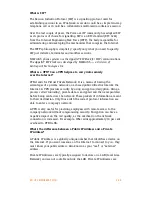
1 2 4
T A L K S W I T C H U S E R G U I D E • U K & I RE L A N D
usually in the range 192.168.x.x, 172.16.x.x or 10.x.x.x. These IP addresses
are used where you have multiple computers all sharing the same Internet
connection.
To access the Internet, a computer or VoIP device must have an IP address. So
what do you do if your ISP (Internet Service Provider) has provided you with
only 1 IP address but you have more than 1 device that requires Internet
access? The solution is to give each of the devices on the LAN a Private IP
Address. A router makes them work by performing Network Address
Translation (NAT — See the next topic for details).
Note that addresses of the form192.168.x.x, 172.16.x.x or 10.x.x.x are not
recognized on the Internet and can only be used for private networks. For
example, if you tell someone on the Internet to connect to you using a
192.168.x.x address, it will not work. Instead, you must provide your real/
Public IP Address.
What is NAT and how does it affect VoIP?
Network Address Translation (NAT) allows multiple devices to share the same
external IP address to access resources on the Internet. NAT is typically used
to allow all the devices in a subscriber’s local area network to access the
Internet through a router with a single public IP address assigned by the
Internet Service Provider.
If a VoIP device is sitting behind a NAT, the private IP address assigned to it is
not usable for communications with the entities outside the private network.
The VoIP device must substitute the private IP address information with the
proper external IP address/port in the mapping chosen by the underlying
NAT to communicate with a particular public peer address/port. TalkSwitch
can automatically check for the current public IP address and substitute the
private IP address with the public address so that VoIP traffic is properly
routed through the NAT.
What’s the difference between a Static IP Address and a Dynamic
IP Address and what effect does this have on VoIP?
A Static IP Address is an address that is permanently assigned to a device.
Typically, a Static IP Address has to be assigned by the network administrator
or Internet Service Provider (ISP).
A Dynamic IP Address is an address that is temporarily assigned to devices by
a DHCP or PPP server that maintains and assigns a pool of IP addresses.
















































